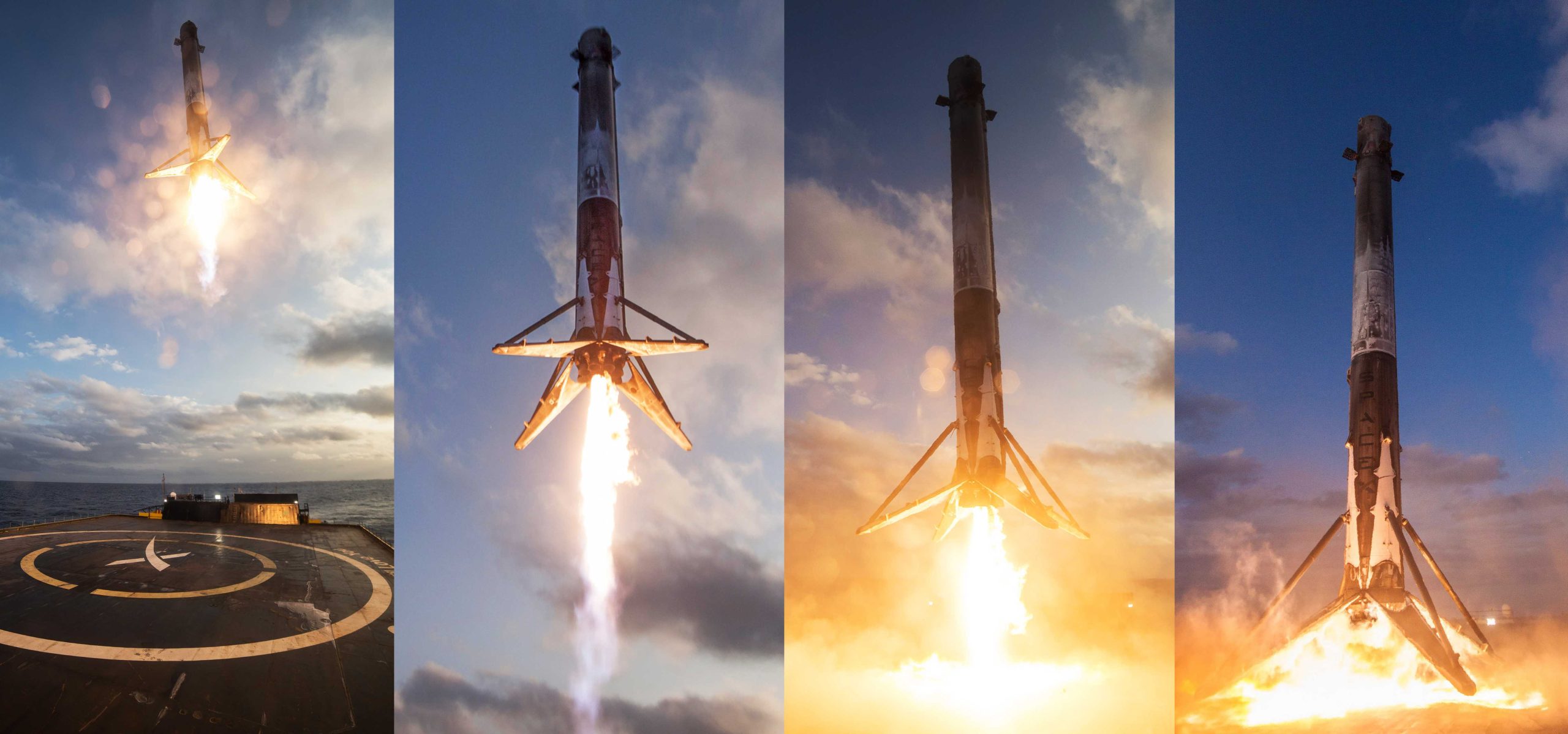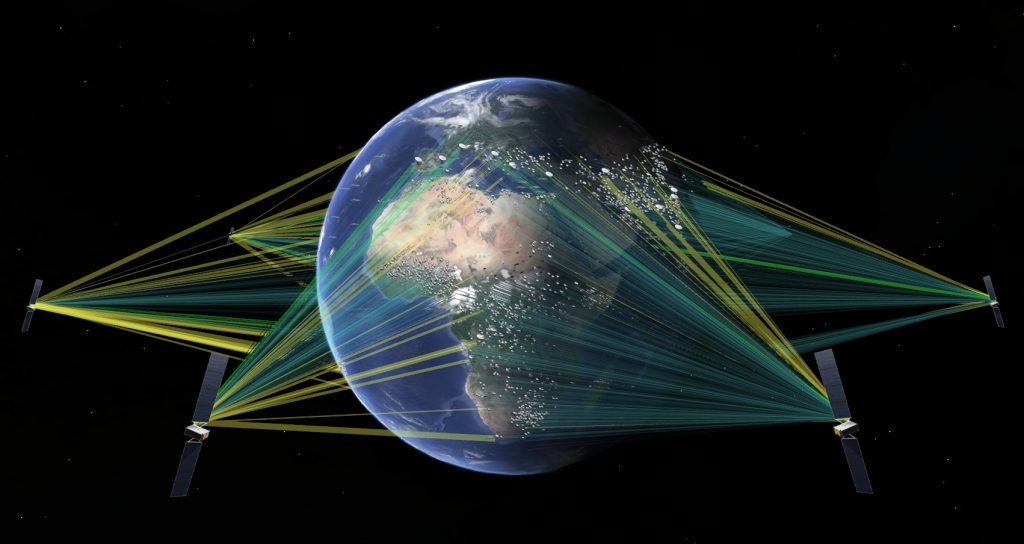

News
SpaceX, SES announce new Falcon 9 launch contracts for seven high-bandwidth satellites
In the midst of the 2019 World Satellite Business Week, SpaceX President and Chief Operating Officer Gwynne Shotwell and SES Satellites CEO Steve Collar announced the latest launch contracts in a long and fruitful relationship.
No earlier than 2021, SpaceX will launch all seven O3b mPOWER communications satellites on two separate Falcon 9 missions, placing the full constellation in a medium Earth orbit (MEO) around 8000 km (5000 mi). Complimenting 20 O3b satellites already in orbit, the seven mPOWER spacecraft will expand the constellation’s bandwidth capabilities by more than a factor of 70, adding 10 terabits per second (Tbps) – almost 1.5 Tbps per satellite – once in orbit.
Collar stated in a press release that “[SES is] delighted to have SpaceX as partners for our historic O3b mPOWER launch, and together, we will extend high-performance connectivity to all who have limited access to it today.” SES looks to extend the already proven concept of its O3b MEO constellation with a new mPOWER constellation, comprised of seven high-throughput, low-latency, adjustable satellites that will serve customers in various markets including telecom, cloud-based, and mobile communications.
The new O3b mPOWER constellation will provide private global connectivity at ten times the throughput, flexibility, and dynamic control of the current O3b constellation. John-Paul Hemingway CEO of SES Networks describes SES as “the only satellite network services provider to operate a global, multi-orbit fleet utilizing an extensive fleet of GEO and MEO satellites.” He also stated that “[SES] believes that the economic and productivity benefits of the cloud should be easily available to all enterprise, maritime and aeronautical customers as well as government organizations, regardless of location.”

SES and SpaceX have a well-established relationship thanks to many previous launch contracts, ranging from SpaceX’s inaugural geostationary satellite launch (SES-8) to SES-10, the world’s first satellite launch on a flight-proven, commercial rocket (Falcon 9). Shotwell stated that “we are pleased that SES has once again selected Falcon 9 to launch their powerful, groundbreaking communications system,– fully supporting our efforts to make rocket reusability a reality. We are proud to play a part in SES bringing revolutionary connectivity solutions to the market.”
The O3b mPOWER constellation is expected to launch form Cape Canaveral, Florida on two SpaceX Falcon 9 rockets no earlier than 2021.
Check out Teslarati’s newsletters for prompt updates, on-the-ground perspectives, and unique glimpses of SpaceX’s rocket launch and recovery processes.

News
Tesla starts rolling out FSD V14.2.1 to AI4 vehicles including Cybertruck
FSD V14.2.1 was released just about a week after the initial FSD V14.2 update was rolled out.

It appears that the Tesla AI team burned the midnight oil, allowing them to release FSD V14.2.1 on Thanksgiving. The update has been reported by Tesla owners with AI4 vehicles, as well as Cybertruck owners.
For the Tesla AI team, at least, it appears that work really does not stop.
FSD V14.2.1
Initial posts about FSD V14.2.1 were shared by Tesla owners on social media platform X. As per the Tesla owners, V14.2.1 appears to be a point update that’s designed to polish the features and capacities that have been available in FSD V14. A look at the release notes for FSD V14.2.1, however, shows that an extra line has been added.
“Camera visibility can lead to increased attention monitoring sensitivity.”
Whether this could lead to more drivers being alerted to pay attention to the roads more remains to be seen. This would likely become evident as soon as the first batch of videos from Tesla owners who received V14.21 start sharing their first drive impressions of the update. Despite the update being released on Thanksgiving, it would not be surprising if first impressions videos of FSD V14.2.1 are shared today, just the same.
Rapid FSD releases
What is rather interesting and impressive is the fact that FSD V14.2.1 was released just about a week after the initial FSD V14.2 update was rolled out. This bodes well for Tesla’s FSD users, especially since CEO Elon Musk has stated in the past that the V14.2 series will be for “widespread use.”
FSD V14 has so far received numerous positive reviews from Tesla owners, with numerous drivers noting that the system now drives better than most human drivers because it is cautious, confident, and considerate at the same time. The only question now, really, is if the V14.2 series does make it to the company’s wide FSD fleet, which is still populated by numerous HW3 vehicles.
News
Waymo rider data hints that Tesla’s Cybercab strategy might be the smartest, after all
These observations all but validate Tesla’s controversial two-seat Cybercab strategy, which has caught a lot of criticism since it was unveiled last year.

Toyota Connected Europe designer Karim Dia Toubajie has highlighted a particular trend that became evident in Waymo’s Q3 2025 occupancy stats. As it turned out, 90% of the trips taken by the driverless taxis carried two or fewer passengers.
These observations all but validate Tesla’s controversial two-seat Cybercab strategy, which has caught a lot of criticism since it was unveiled last year.
Toyota designer observes a trend
Karim Dia Toubajie, Lead Product Designer (Sustainable Mobility) at Toyota Connected Europe, analyzed Waymo’s latest California Public Utilities Commission filings and posted the results on LinkedIn this week.
“90% of robotaxi trips have 2 or less passengers, so why are we using 5-seater vehicles?” Toubajie asked. He continued: “90% of trips have 2 or less people, 75% of trips have 1 or less people.” He accompanied his comments with a graphic showing Waymo’s occupancy rates, which showed 71% of trips having one passenger, 15% of trips having two passengers, 6% of trips having three passengers, 5% of trips having zero passengers, and only 3% of trips having four passengers.
The data excludes operational trips like depot runs or charging, though Toubajie pointed out that most of the time, Waymo’s massive self-driving taxis are really just transporting 1 or 2 people, at times even no passengers at all. “This means that most of the time, the vehicle being used significantly outweighs the needs of the trip,” the Toyota designer wrote in his post.
Cybercab suddenly looks perfectly sized
Toubajie gave a nod to Tesla’s approach. “The Tesla Cybercab announced in 2024, is a 2-seater robotaxi with a 50kWh battery but I still believe this is on the larger side of what’s required for most trips,” he wrote.
With Waymo’s own numbers now proving 90% of demand fits two seats or fewer, the wheel-less, lidar-free Cybercab now looks like the smartest play in the room. The Cybercab is designed to be easy to produce, with CEO Elon Musk commenting that its product line would resemble a consumer electronics factory more than an automotive plant. This means that the Cybercab could saturate the roads quickly once it is deployed.
While the Cybercab will likely take the lion’s share of Tesla’s ride-hailing passengers, the Model 3 sedan and Model Y crossover would be perfect for the remaining 9% of riders who require larger vehicles. This should be easy to implement for Tesla, as the Model Y and Model 3 are both mass-market vehicles.
Elon Musk
Elon Musk and James Cameron find middle ground in space and AI despite political differences
Musk responded with some positive words for the director on X.

Avatar director James Cameron has stated that he can still agree with Elon Musk on space exploration and AI safety despite their stark political differences.
In an interview with Puck’s The Town podcast, the liberal director praised Musk’s SpaceX achievements and said higher priorities must unite them, such as space travel and artificial intelligence. Musk responded with some positive words for the director on X.
A longtime mutual respect
Cameron and Musk have bonded over technology for years. As far back as 2011, Cameron told NBC News that “Elon is making very strong strides. I think he’s the likeliest person to step into the shoes of the shuttle program and actually provide human access to low Earth orbit. So… go, Elon.” Cameron was right, as SpaceX would go on to become the dominant force in spaceflight over the years.
Even after Musk’s embrace of conservative politics and his roles as senior advisor and former DOGE head, Cameron refused to cancel his relationship with the CEO. “I can separate a person and their politics from the things that they want to accomplish if they’re aligned with what I think are good goals,” Cameron said. Musk appreciated the director’s comments, stating that “Jim understands physics, which is rare in Hollywood.”
Shared AI warnings
Both men have stated that artificial intelligence could be an existential threat to humanity, though Musk has noted that Tesla’s products such as Optimus could usher in an era of sustainable abundance. Musk recently predicted that money and jobs could become irrelevant with advancing AI, while Cameron warned of a deeper crisis, as noted in a Fox News report.
“Because the overall risk of AI in general… is that we lose purpose as people. We lose jobs. We lose a sense of, ‘Well, what are we here for?’” Cameron said. “We are these flawed biological machines, and a computer can be theoretically more precise, more correct, faster, all of those things. And that’s going to be a threshold existential issue.”
He concluded: “I just think it’s important for us as a human civilization to prioritize. We’ve got to make this Earth our spaceship. That’s really what we need to be thinking.”









